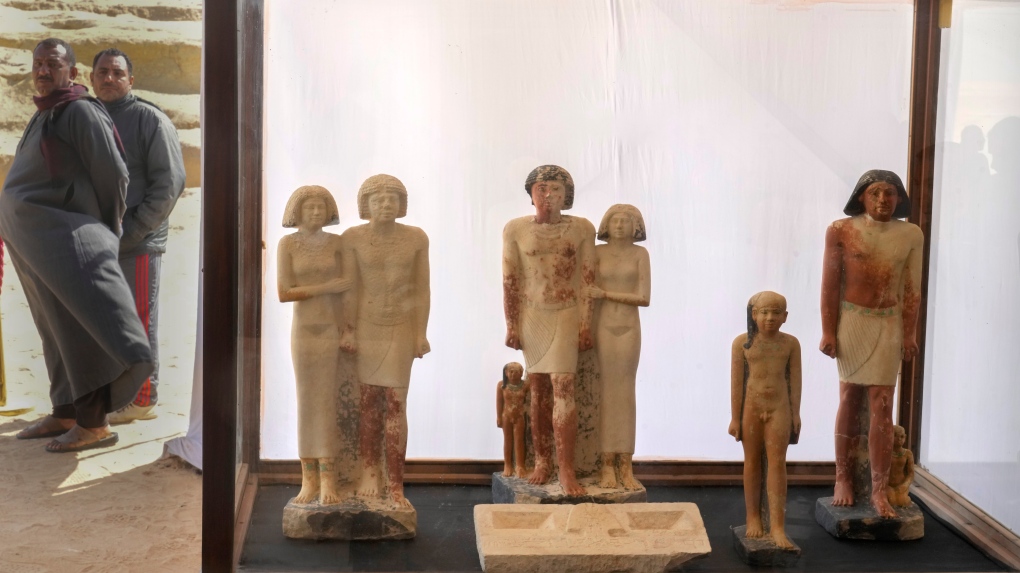
Ontario to ban use of cellphones in school classrooms starting in September
Ontario is introducing a suite of measures that will crack down on cellphone use and vaping in schools.
Egypt on Thursday unveiled dozens of new archeological discoveries, including two ancient tombs, at a Pharaonic necropolis just outside of the capital Cairo.
The artefacts, unearthed during a year-long excavation, were found beneath an ancient stone enclosure near the Saqqara pyramids and date back to the fifth and sixth dynasties of the Old Kingdom, spanning from roughly 2500 B.C to 2100 B.C., the excavation team said.
One of the uncovered tombs belonged to a priest from the fifth dynasty known as Khnumdjedef, while the other tomb belonged to an official named Meri, a palace official who held the title of "the keeper of the secrets," the team said. Other major findings from the excavation include statues, amulets, and a well-preserved sarcophagus.
Egypt's most renowned archeologist and director of the excavation, Zahi Hawass, personally unveiled the new discoveries from the stone enclosure, known as Gisr al-Mudir.
"I put my head inside to see what was inside the sarcophagus: A beautiful mummy of a man completely covered in layers of gold," Hawass said.
The Saqqara site is part of a sprawling necropolis at Egypt's ancient capital of Memphis that includes the famed Giza Pyramids as well as smaller pyramids at Abu Sir, Dahshur and Abu Ruwaysh. The ruins of Memphis were designated a UNESCO World Heritage site in the 1970s.
Thursday's unveiling comes amid a flurry of new discoveries announced by Egyptian authorities over the past week. Near the southern city of Luxor, authorities said they found dozens of burial sites from the New Kingdom era, dating from 1800 B.C. to 1600 B.C. Discovered nearby were the ruins of an ancient Roman city, it said.
In a separate announcement Tuesday, a group of scientists from Cairo University revealed previously unknown details about a mummified teenage boy dating to about 300 B.C. By using CT scans, the team of scientists were able to shed new light on the boy's high social status by affirming the intricate details of the amulets inserted within his mummified body and the type of burial he received.
Egypt often publicly touts its ancient discoveries to attract more tourists, a significant source of foreign currency for the cash-strapped North African country. The sector suffered a long downturn after the political turmoil and violence that followed a 2011 uprising.
Egypt's tourist industry was also hit hard by the coronavirus pandemic and is currently suffering from the fallout from the war in Ukraine. Both Russia and Ukraine formerly comprised a large source of tourists visiting Egypt.
------
Associated Press writer Jack B. Jeffery contributed to this report from Cairo.

Ontario is introducing a suite of measures that will crack down on cellphone use and vaping in schools.
A recent report sheds light on Canadians living abroad--estimated at around four million people in 2016—and the public policies that impact them.
Raneem, 10, lives with a neurological condition and liver disease and needs Cholbam, a medication, for a longer and healthier life.
Ontario is now home to an invasive and toxic worm species that can grow up to three feet long and can be dangerous to small animals and pets.
Laurentian University's board of governors approved a budget of just over $201.7 million for the 2024-2025 fiscal year.
One person has been charged with second-degree murder in connection with the death of a man who fell from a balcony following an altercation inside a Toronto apartment building.
Dozens of people raised their arms in the fascist salute and shouted a fascist chant during ceremonies Sunday to honor Italian dictator Benito Mussolini on the 79th anniversary of his execution.
The Canadian Food Inspection Agency has issued a recall for a specific chocolate brand sold in Ontario and Quebec.
Zendaya and castmates Mike Faist and Josh O’Connor have been on a globetrotting press tour to get the word out about Italian director Luca Guadagnino's original film, which opened in 3,477 locations in the U.S. and Canada.

As if a 4-0 Edmonton Oilers lead in Game 1 of their playoff series with the Los Angeles Kings wasn't good enough, what was announced at Rogers Place during the next TV timeout nearly blew the roof off the downtown arena.
Mounties in Nanaimo, B.C., say two late-night revellers are lucky their allegedly drunken antics weren't reported to police after security cameras captured the men trying to steal a heavy sign from a downtown business.
A property tax bill is perplexing a small townhouse community in Fergus, Ont.
When identical twin sisters Kim and Michelle Krezonoski were invited to compete against some of the world’s most elite female runners at last week’s Boston Marathon, they were in disbelief.
The giant stone statues guarding the Lions Gate Bridge have been dressed in custom Vancouver Canucks jerseys as the NHL playoffs get underway.
A local Oilers fan is hoping to see his team cut through the postseason, so he can cut his hair.
A family from Laval, Que. is looking for answers... and their father's body. He died on vacation in Cuba and authorities sent someone else's body back to Canada.
A former educational assistant is calling attention to the rising violence in Alberta's classrooms.
The federal government says its plan to increase taxes on capital gains is aimed at wealthy Canadians to achieve “tax fairness.”
 Egyptian antiquities guarders stand behind recently discovered artifacts at the site of the Step Pyramid of Djoser in Saqqara, Egypt, Jan. 26, 2023. (AP Photo/Amr Nabil)
Egyptian antiquities guarders stand behind recently discovered artifacts at the site of the Step Pyramid of Djoser in Saqqara, Egypt, Jan. 26, 2023. (AP Photo/Amr Nabil)